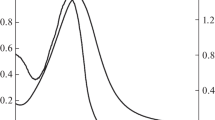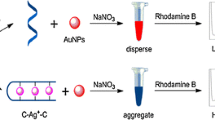Abstract
It is found that silver nanoparticles (AgNPs) can further enhance the fluorescence intensity of curcumin (CU) - cetyltrimethylammonium bromide (CTAB) – nucleic acids and improve its anti-photobleaching activity. Under optimum conditions, the enhanced fluorescence intensity is proportion to the concentration of nucleic acids in the range of 2.0 × 10−8–1.0 × 10−6 g mL−1 for fish sperm DNA (fsDNA), 2.0 × 10−8–1.0 × 10−6 g mL−1 for calf thymus DNA (ctDNA), 1.0 × 10−8–1.0 × 10−6 g mL−1 for yeast RNA (yRNA), and their detection limits (S/N = 3) are 8.0 ng mL−1, 10.5 ng mL−1 and 5.8 ng mL−1, respectively. This method is used for determining the concentration of DNA in actual sample with satisfactory results. The interaction mechanism is also studied.










Similar content being viewed by others
References
Dick LA, McFarland AD, Haynes CL, Duyne RPV (2002) Metal Film over Nanosphere (MFON) Electrodes for Surface-Enhanced Raman Spectroscopy (SERS): improvements in Surface Nanostructure Stability and Suppression of Irreversible Loss. J Phys Chem B 106:853–860. doi:10.1021/jp013638l
Nicewarner-Pena SR, Freeman RG, Reiss BD, He L, Pena DJ, Walton ID, Cromer R, Keating CD, Natan MJ (2001) Submicrometer metallic barcodes. Science 294:137–141. doi:10.1126/science.294.5540.137
Geerts H, Brabander MD, Nuydens R (1991) Nanovid microscopy. Nature 351:765–766. doi:10.1038/351765a0
Hainfeld JF, Powell RD (2000) New frontiers in gold labeling. J Histochem Cytochem 48:471–480
Tian N, Zhou ZY, Sun SG, Ding Y, Wang ZL (2007) Synthesis of tetrahexahedral platinum nanocrystals with high-index facets and high electro-oxidation activity. Science 316:732–735. doi:10.1126/science.1140484
Zhang JG, Gao Y, Alvarez-Puebla RA, Buriak JM, Fenniri H, Buriak JM (2006) Synthesis and SERS properties of nanocrystalline gold octahedra generated from thermal decomposition of HAuCl4 in block copolymers. Adv Mater 18:3233–3237. doi:10.1002/adma.200601368
Yin HQ, Langford R, Burrel RE (1999) Comparative evaluation of the antimicrobial activity of ACTICOAT antimicrobial barrier dressing. J Burn Care Rehabil 20:195–200. doi:10.1097/00004630-199905000-00006
Tian J, Wong KY, Ho CM, Lok CN, Yu WY, Che CM, Chiu JF, Tam PH (2007) Topical delivery of silver nanoparticles promotes wound healing. Chem Med Chem 2:129–136. doi:10.1002/cmdc.200600171
Elechiguerra JL, Burt JL, Morones JR, Camacho-Bragado A, Gao X, Lara HH, Yacaman MJ (2005) Interaction of silver nanoparticles with HIV-1. J Nanobiotechnol 3:6. doi:10.1186/1477-3155-3-6
Braun E, Eichen Y, Sivan U, Ben-Yoseph G (1998) DNA-templated assembly and electrode attachment of conducting silver wire. Nature 391:775–778. doi:10.1038/35826
Xiong YJ, Xie Y, Wu CZ, Yang J, Li ZQ, Xu F (2003) Formation of silver nanowires through a sandwiched reduction process. Adv Mater 15:405–408. doi:10.1002/adma.200390092
Petty JT, Zheng J, Hud NV, Dickson RM (2004) DNA-templated Ag nanocluster formation. J Am Chem Soc 126:5207–5212. doi:10.1021/ja031931o
Sun LL, Wei G, Song YH, Liu ZG, Wang L, Li Z (2006) Fabrication of silver nanoparticles ring templated by plasmid DNA. Appl Surf Sci 252:4969–4974. doi:10.1016/j.apsusc.2005.07.016
Pan Q, Zhang RY, Bai YF, He NY, Lu ZH (2008) An electrochemical approach for detection of specific DNA-binding protein by gold nanoparticle-catalyzed silver enhancement. Anal Biochem 375:179–186. doi:10.1016/j.ab.2007.12.006
Zheng JH, Wu X, Wang MQ, Ran DH, Xu W, Yang JH (2008) Study on the interaction between silver nanoparticles and nucleic acids in the presence of cetyltrimethylammonium bromide and its analytical application. Talanta 74:526–532. doi:10.1016/j.talanta.2007.06.014
Bao P, Frutos AG, Greef C, Lahiri J, Muller U, Peterson TC, Warden L, Xie XY (2002) High-sensitivity detection of DNA hybridization on microarrays using resonance light scattering. Anal Chem 74:1792–1797. doi:10.1021/ac0111964
Chattopadhyay I, Biswas K, Bandyopadhyay U, Banerjee RK (2004) Banerjee turmeric and curcumin: biological actions and medicinal applications. Curr Sci 87:44–53
Maheshwari RK, Singh AK, Gaddipati J, Srimal RC (2006) Multiple biological activities of curcumin: a short review. Life Sci 78:2081–2087. doi:10.1016/j.lfs.2005.12.007
Ono K, Hasegawa K, Naike H, Yamada MJ (2004) Curcumin has potent anti-amyloidogenic effects for Alzheimer’s beta-amyloid fibrils in vitro. J Neurosci Res 75:742–750. doi:10.1002/jnr.20025
Balasubramanian KJ (2006) Molecular orbital basis for yellow curry spice curcumin’s prevention of Alzheimer’s disease. Agric Food Chem 54(10):3512–3520. doi:10.1021/jf0603533
Park SY, Kim DS (2002) Discovery of natural products from Curcuma longa that protect cells from beta-amyloid insult: a drug discovery effort against Alzheimer’s disease. J Nat Prod 56:1227–1231. doi:10.1021/np010039x
Shishodia S, Potdar P, Gairola CG, Aggarwal BB (2003) Curcumin (diferuloylmethane) down- regulates cigarette smoke-induced NF- kappaB activation through inhibition of IkappaBalpha kinase in human lung epithelial cells: correlation with suppression of COX-2, MMP-9 and cyclin D1. Carcinogenesis 24:1269–1279. doi:10.1093/carcin/bgg078
Khopde SM, Priyadarsini KI, Palit DK, Mukherjee T (2000) Effect of solvent on the excited state photophysical properties of curcumin. Photochem Photobiol 72:625–631. doi:10.1562/0031-8655(2000)072<0625:EOSOTE>2.0.CO;2
Tonnesen HH, Karlsen J, Mostad A (1982) Structural studies of curcuminoids. 1. The crystal structure of curcumin. Acta Chem Scand B 36:475–479. doi:10.3891/acta.chem.scand.36b-0475
Zsila F, Bikadi Z, Simonyi M (2003) Molecular basis of the Cotton effects induced by the binding of curcumin to human serum albumin. Tetrahedron Asymmetry 14:2433–2444. doi:10.1016/S0957-4166(03)00486-5
Pedersen U, Rasmussen PB, Lawesson SO (1985) Synthesis of naturally occurring curcuminoids and related-compounds. Liebigs Ann Chem 8:1557–1569. doi:10.1002/jlac.198519850805
Sokolov K, Chumanov G, Cotton TM (1998) Enhancement of molecular fluorescence near the surface of colloidal metal films. Anal Chem 70:3898–3905. doi:10.1021/ac9712310
Zhang ZL, Huang WM, Tang JL, Wang EK, Dong SJ (2002) Conformational transition of DNA induced by cationic lipid vesicle in acidic solution: spectroscopy investigation. Biophys Chem 97:7–16. doi:10.1016/S0301-4622(02)00006-6
Zhou YL, Li YZ (2004) Studies of interaction between poly(allylamine hydrochloride) and double helix DNA by spectral methods. Biophys Chem 107:273–281
Nakajima A (1983) A study on the system of pyrene and β-cyclodextrin in aqueous solution utilizing the intensity enhancement phenomenon. Spectrochim Acta A 39(10):913–915
Shinitzky M, Barenholz Y (1978) Fluidity parameters of lipid regions determined by fluorescence polarization. Biochem Biophys Acta 515(4):367–394
Acknowledgment
This work is supported by Natural Science Foundations of China (20575035) and Shandong Province(Z2008B04).
Author information
Authors and Affiliations
Corresponding authors
Rights and permissions
About this article
Cite this article
Zhou, H., Wu, X., Xu, W. et al. Fluorescence Enhancement of the Silver Nanoparticales – Curcumin - Cetyltrimethylammonium Bromide-nucleic Acids System and its Analytical Application. J Fluoresc 20, 843–850 (2010). https://doi.org/10.1007/s10895-010-0627-z
Received:
Accepted:
Published:
Issue Date:
DOI: https://doi.org/10.1007/s10895-010-0627-z




